RARE! WWII USS Enterprise Lt. Moore Taroa D-Day Aircraft Aerial Raid Strike
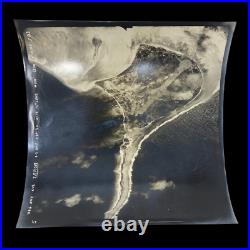
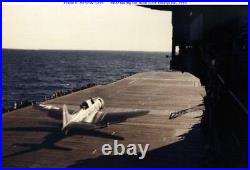
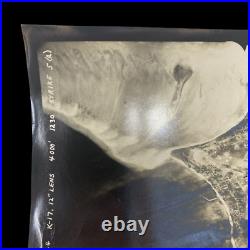
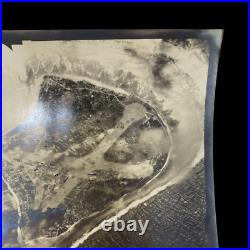
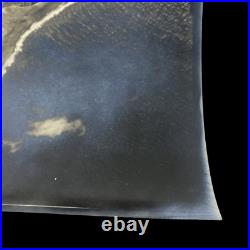
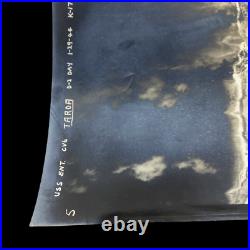
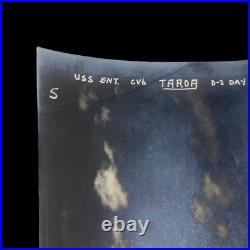
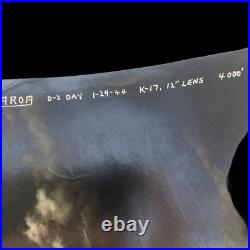
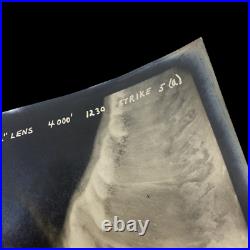
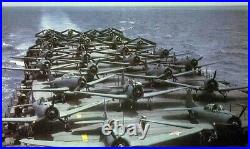

Size: 9.5 x 9.75 inches. Shows STIKE 5 on D-2 Day. As far as we know this is the only original aerial photograph produced by the USS ENTERPRISE of the Tarao D-Day raid.
There were multiple aerial photographs taken by Lt. Moore and other USS Enterprise pilots during these raids... But this is the only copy of this specific photograph we have found in any archival or historical database...
Making it 1 of 1! This is a VERY rare aerial photograph and WWII artifact... Sure to be the prized piece of your WWII collection! USS Enterprise items rarely come to market and are as rare as some of the most high end WWII memorabilia. Dated 1-29-44, this original'RESTRICTED' World War II USS Enterprise aerial reconnaissance photograph is marked "Taroa D-2 Day" and was taken by a U.
Enterprise air group pilot and is also labeled with USS ENT. Taken with a K-17 aerial camera, the K-17 camera was originally designed as an all-purpose aerial camera and was used widely throughout World War II for vertical mapping, photography, and all types of aerial reconnaissance intelligence and bomb damage assessment. This aerial photograph was taken while flying over the Japanese held island of Taroa.Following the pilots combat mission in the area, and their safe landing aboard the deck of the USS Enterprise this photograph was then developed aboard the carrier's photographic development crew and was marked, used, and examined by USS Enterprise pilots such as Lt. Moore and other USS Enterprise high ranking commanders and officers.
Was used extensively by Lt. Moore who served as an American pilot on the USS Enterprise (CV-6) Air Group. Moore is a WWII American hero who served as a U. Carrier combat pilot aboard the USS Enterprise and saw action in some of WWII's most infamous battles. It was here he covered the landings and participated in the battles of Eastern Solomons and Santa Cruz Islands.
Despite the USS Enterprise being damaged in both battles, USS Enterprise launched Lt. In late 1943 and early 1944, Enterprise took part in the Gilberts and Marshall invasions and air attacks on the Japanese in the Central and Southern Pacific. In the summer of 1944, USS Enterprise participated in the Marianas operation and the Battle of the Philippine Sea, followed with the largest naval battle in history, the Battle of Leyte Gulf in October. Moore took part in the aerial attack of the Iwo Jima invasion, then raids on the Japanese home islands and the Okinawa campaign in April.
Navy warship during the war. Following Japan's surrender, she helped transport U. Servicemen back to the United States. Moore survived the length of the war flying countless aerial combat missions and raids against the Japanese aboard what is considered one of the most infamous U. In Enterprise, Halsey and his Chief of Staff, CDR Miles Browning, had developed a plan for the raid.
Force - commanded by Rear Admiral Frank Jack Fletcher - would target Makin, in the Gilbert Islands, and Jaluit and Mili in the southern Marshalls. Accompanied by Spruance's cruisers, set their sights on Wotje and Taroa (in the Maloelap atoll) in the northern Marshalls.As the Marshalls were suspected of being well-defended, this seemed like a long enough list of targets. New intelligence received January 27, courtesy the submarine. Browning - a brilliant and aggressive tactician at a time when the Navy desperately needed such men - convinced Halsey to add Kwajalein to his target list. Doing so entailed considerable risk.
In order to bring Kwajalein within range of her bombers. Would have to operate dangerously close to enemy bases on Wotje and Taroa. Now, though, it was apparent that. Striking Kwajalein would be just as dangerous.
Would be in range of enemy land-based bombers from the atoll. It was imperative that enemy airfields on Kwajalein and the other islands be struck, and struck hard, before they had opportunity to launch possibly killing blows against the vulnerable carrier. For two more days, the two task forces cruised northwest together, the most notable event being.
Refueling underway the night of January 28. Under the best conditions - in daylight - refueling underway is a dangerous, exacting task. On this day, the oiler. In another two years, this capability - refined and repeated until it was a matter of course - would enable US Navy warships to operate far from friendly anchorages for a month or more at a time, but on this night minds were on more immediate concerns. And their respective task forces parted ways, and early the next morning swept across the International Date Line into January 31.With less than 24 hours remaining before their first offensive mission of the war, the men of. And her Air Group prepared.
Fighting Six installed homemade armor - literally made of boilerplate - behind the seat of each Wildcat, a vital if weighty addition their Japanese counterparts would never consider. Navigators and airmen poured over aged maps, picking out reefs and targets. At 1830, Task Force 8 began its final run-in to the launching point, the ocean waves hissing past hulls at 30 knots, each of.
S four 13-ton propellers revolving 275 times a minute. The night passed uneventfully until, at 0220, the officer of the watch reported sand blowing in his face.
The officer then thought to taste a few grains of the "sand". Finding they were suspiciously sweet, he soon traced their source to a sailor on watch, stirring sugar into his coffee. The first missions were timed to reach their targets throughout the northern Marshall Islands simultaneously, just before 0700: the same time that Spruance's cruiser force was to commence bombardment of Wotje and Taroa. Thirteen minutes later, six F4F Wildcats roared into the black night for Combat Air Patrol, followed immediately 36 Scouting Six and Bombing Six SBDs led by.Air Group commander CDR Howard L. Just after 0500, a second strike of nine TBD Devastators from Torpedo Six, and an SBD delayed by engine trouble, rumbled down the Big E's flight deck. These 46 planes formed up in the dark - no easy task - and headed for Kwajalein Atoll, 155 miles away. At 0610, still nearly an hour before sunrise, twelve Fighting Six Wildcats were launched for Wotje and Taroa. One Wildcat pilot, ENS David W.
Criswell, apparently became disoriented in the dark. His plane stalled shortly after takeoff and plunged into the sea: Criswell was never found. Considering the limited training given pilots in night operations before the war, it's remarkable there weren't further mishaps. On this first strike, each Devastator torpedo plane was armed with three 500 lb instantaneous-fused bombs - rather than the usual torpedo - while the Dauntlesses each lugged a single 500 lb bomb as well as two 200 lb bombs. The Wildcats carried two 100 lb bombs each. As the planes droned through the pre-dawn darkness, Spruance's cruisers closed range with Wotje and Taroa. And several destroyers sidled up to Taroa. Shortly before 0700, Gene Lindsey's torpedo planes broke off from the main body of Dauntlesses and headed for Kwajalein anchorage, some 44 miles south of Roi at the northern end of the atoll. "Brigham" Young's SBDs, meanwhile, grappled with darkness, low-lying fog, and decades-old maps, trying to identify Roi itself. At 0705, seven minutes after the strikes were scheduled to begin, and - more importantly - after the defenders on the ground had been alerted to their approach, they succeeded. In a steep, gliding run, LCDR Halstead L.Hopping led his division of six SBDs through increasing anti-aircraft fire, releasing his bombs over the enemy's airfield, where even as the attack begin, fighters were scrambling into the air. As the lead plane, Hopping's SBD drew much of the defenders' fire and plunged into the sea after releasing its bomb: Hopping and his gunner, RM 1/c Harold Thomas, were lost. Scouting Six continued the attack, with Earl Gallaher and C. Dickinson each leading six SBDs into the fray.
The bombers pummeled the airfield - destroying an ammunition dump, two hangars, and a radio station - and swung back around to strafe the base and parked planes on the ground. Enemy fighters and anti-aircraft fire claimed three more SBDs, but. With Roi in a shambles, seven marauding VS-6 SBDs - their big 500 lb bombs still slung under their bellies - made off for Kwajalein anchorage, where more substantial targets had been reported by Torpedo Six commander Gene Lindsey. In the anchorage, Lindsey had immediately called for more planes. Over Roi, Young picked up and repeated Lindsey's alert - "Targets suitable for heavy bombs at Kwajalein anchorage" - before detaching Bombing Six with the seven accompanying Scouting Six planes.Young's broadcast was heard aboard. Where the remaining nine VT-6 Devastators were armed with torpedoes and readied for launch. Bombing Six, led by LCDR William R. Hollingsworth, and the remaining planes of VS-6, followed up with a dive-bombing attack from 14,000 feet. On their departure, the transport.
Comprehensive WWII combat history of USS. The Yorktown class aircraft carrier, USS Enterprise (CV-6) was commissioned at Newport News, Virginia, on May 12, 1938. Relocating to the Pacific, she was at sea during the Japanese Attack on Pearl Harbor on December 7, 1941. Three days after, she became the first U.
Navy warship to sink a Japanese warship, submarine I-70, and later that month participated in the Wake Island expedition. In April, Enterprise covered the Dootlittle Raid on Japan and participated in the Battle of Midway that June, where her planes helped sink three Japanese aircraft carriers and a cruiser.During the Guadalcanal Campaign, she covered the landings and participated in the battles of Eastern Solomons and Santa Cruz Islands. Decommissioned in February 1947, Enterprise was re-designated (CVA-6) in October 1952 and then to (CVS-6) in August 1953. This item is in the category "Collectibles\Militaria\WW II (1939-45)\Original Period Items\United States\Field Gear, Equipment". The seller is "premierrelics" and is located in this country: US.
This item can be shipped worldwide.- Theme: Militaria
- Original/Reproduction: Original
- Conflict: WW II (1939-45)
